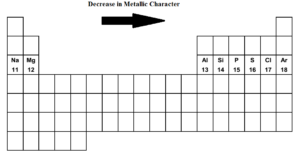Science > Chemistry > Third Row Elements > Metallic Character of Third Row Elements
In this article, we shall study the trend im metallic character of third row elements.
Metallic Character:
The tendency of an atom to lose electrons to form positively charged ion is called its metallic character or electropositive character. Typically metals show luster and are good conductors of heat and electricity.
Non-Metallic Character:
The tendency of an atom to gain electrons to form negatively charged ion is called its non-metallic character or electronegative character.
Factors affecting metallic and non-metallic characters:
- Size of an atom
- Ionization enthalpy
- Nuclear charge
Trends in metallic and non-metallic characters:

As we move across the periodic table from left to right i.e. from sodium to argon in the third period metallic character decreases and non-metallic character increases. Sodium, magnesium, aluminium are typical metals. Silicon is metalloid. (weakly non- metallic). Phosphorous, Sulphur, Chlorine are non-metals. Argon is an inert gas.
Sodium is the most metallic element while chlorine is the most non-metallic element. Both the extreme elements sodium and chlorine are extremely reactive. Argon is neither electropositive nor electronegative.
Scientific Reasons:
As we move across the periodic table from left to the right i.e. from sodium to Argon in the third period metallic character decreases and non-metallic character increases.
As we move from left to right in the third period the atomic number goes on increasing. Thus as we move from sodium to argon the nuclear charge increases and from left to right additional electron is added to the same i.e. third orbit. Due to increase in the nuclear charge the attractive force on electrons in outermost orbit increases and thus the size of atom decreases.
As we move from left to right in the third period the ionization enthalpy increases. From left to right in the third-period electronegativity increases i.e. the tendency of losing electrons decreases and tendency of gaining electrons increases. As we move from left to right in the third-period number of valence increases. Hence as we move across the periodic table from left to the right i.e. from sodium to Argon in the third period metallic character decreases and non-metallic character increases.
Sodium, Magnesium, Aluminium are typical metals.
Metallic and non-metallic characters of the elements depend on their atomic size, nuclear charge and ionization potential. Sodium, magnesium, aluminium have atomic numbers 11, 12, 13 respectively. They contain 1, 2, 3 valence electrons in their outermost shell.
Compared to other elements in the third row their atomic sizes are larger. Similarly, the nuclear charges are also less. Due to this attractive force on valence electrons is less. Compared to other elements in the third row their ionization enthalpies are lower. Thus the tendency of these elements is to lose their valence electrons. Hence sodium, magnesium, aluminium are typical metals.
Phosphorous, Sulphur, Chlorine are non-metals.
Metallic and non-metallic characters of the elements depend on their atomic size, nuclear charge and ionization potential. Phosphorous, sulphur, chlorine have atomic numbers 15, 16, 17 respectively. They contain 5, 6, 7 valence electrons in their outermost shell.
Compared to other elements in the third row their atomic sizes are smaller. Similarly, the nuclear charges are also more. Due to this attractive force on valence electrons is more. Compared to other elements in the third row their ionization enthalpies are higher. Thus the tendency of these elements is not to lose their valence electrons but to gain electrons. Hence phosphorous, sulphur, chlorine are non-metals.
Argon is neither electropositive nor electronegative element.
Metallic and non-metallic characters of the elements depend on their atomic size, nuclear charge and ionization potential. Argon has atomic number 18. It contains 8 valence electrons in their outermost shell. Argon has completed octet and completely filled s and p orbitals thus it has the most stable electronic configuration in third-row elements which it will not disturb by accepting or losing the electron.
Compared to other elements in the third row its atomic sizes are larger but the effect of filled s and p orbitals is dominating. Compared to other elements in the third row its ionization enthalpy is the highest. Thus the tendency of Argon to lose or gain valence electrons is almost absent. Hence Argon is neither electropositive nor electronegative element.
Sodium is the most metallic element.
Metallic and non-metallic characters of the elements depend on their atomic size, nuclear charge and ionization potential. Sodium has atomic numbers 11. It contains 1 valence electron in its outermost shell.
Compared to other elements in the third row its atomic size is larger. Similarly, the nuclear charge is also less. Due to this attractive force on valence electron is less. Compared to other elements in the third row its ionization enthalpy is the lowest. Thus the tendency of Sodium is to lose its valence electron. Hence Sodium is the most metallic element.
Chlorine is the most non-metallic element.
Metallic and non-metallic characters of the elements depend on their atomic size, nuclear charge and ionization potential. Chlorine has atomic number 17. It contains 7 valence electrons in its outermost shell.
Compared to other elements in the third row its atomic size is the smallest. Similarly, the nuclear charge is also more. Due to this attractive force on valence electrons is more. Compared to other elements in the third row its ionization enthalpy is the highest. Thus the tendency of Chlorine is not to lose its valence electrons but to gain electrons. Hence Chlorine is the most non-metallic element.